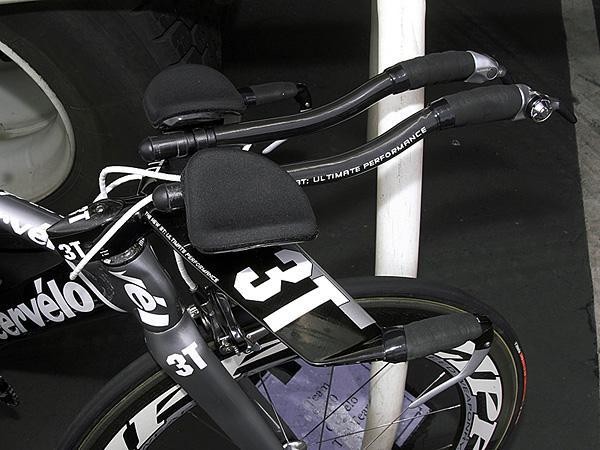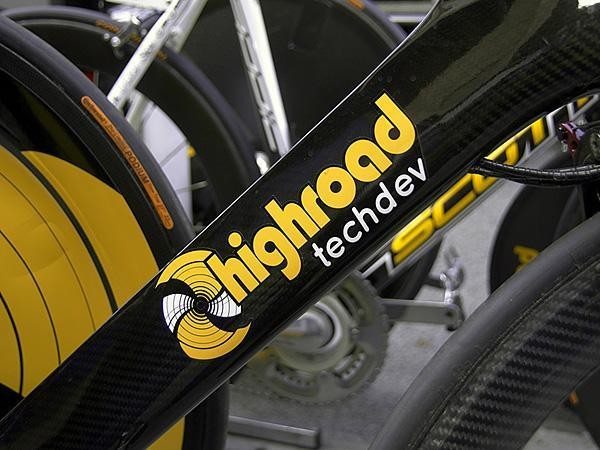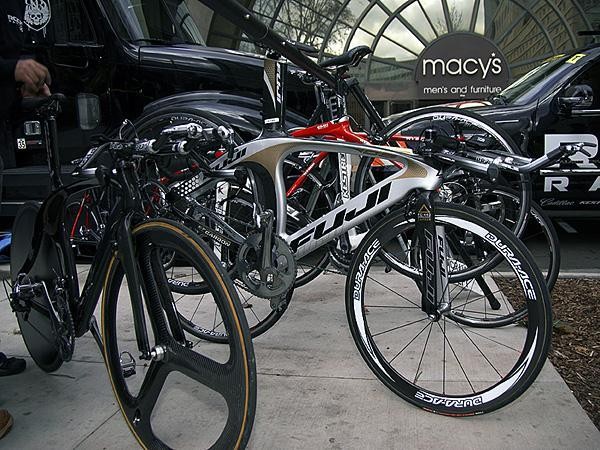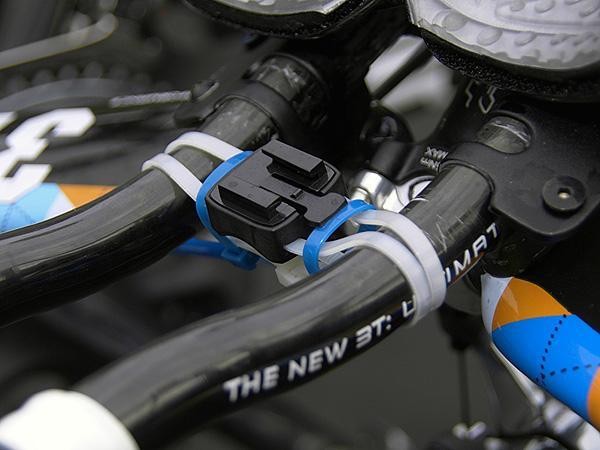Time trial tech from the Tour of California
Scott Bicycles signed on as the official bicycle sponsor for Team Columbia-Highroad this season and...




Race tech: Tour of California, February 15, 2009
Clearing up the confusion about the Team Columbia-High Road time trial machines
Scott Bicycles signed on as the official bicycle sponsor for Team Columbia-Highroad this season and riders have been suitably equipped with Addict SL machines for the road. Though a few riders have now been set up on the Scott Plasma 2 for time trials, most of the team at the Tour of California is still aboard the radical custom time trial rigs they used last year with Giant, now more cryptically dressed in black and yellow ‘Highroad Techdev' livery.
So is it merely a matter of a new sponsor being unable to provide bikes in time? That depends on whom you ask. According to team owner Bob Stapleton, the bike is the product of team development work done in conjunction with Giant but it's not a Giant bike.
"As you know, Giant was our bike manufacturer last year and the Giant TT bike that we raced last year was developed in conjunction with Giant, some external experts, as well as engineers within our own team," he said. "So this year we're racing a bike made by a company that I can't disclose that's had engineering input from many of those same people and is a different bike. As you can see it's branded ‘Highroad Techdev'.
"We're becoming more and more involved in design and development of better products with all of our partners now," Stapleton continued. "So Techdev is really a collaborative effort with Scott, Shimano, HED, and some external experts. We've got the best possible tools for our athletes to use and those ultimately become better products for our consumers to buy. So that's really showing our commitment to leading-edge technology with the team."
Not surprisingly, Giant global marketing manager An Le has a distinctly different take on the situation.
Get The Leadout Newsletter
The latest race content, interviews, features, reviews and expert buying guides, direct to your inbox!
"They're Giant bikes and Giant's intellectual property," he said. "That's why Rabobank is racing on it this year. Any brand that sponsors a team will work with them to develop new technology. Giant basically paid for the development of a new bike, we manufactured the bike in our own factory, we supply the bike to Rabobank, and that's really what's going to happen when we ultimately bring the bike to market. When they do go to market, they'll be Giant bikes. There's no contention from our end; it's pretty clear."
Thankfully the situation is not as volatile as it potentially could be. Though Highroad officially contests the ownership of the technology, Stapleton said the team would only be using the distinctive aero machines until something could be developed with new sponsor Scott.
Moreover, Le's comments also confirm our questions regarding the possible public availability of the as yet unnamed bike. Though he says the current iteration ridden by Rabobank is still a development prototype, the project is well into its later stages and is likely months – not years – away from being launched as an actual Giant product.
Time trial frame issues aside, Highroad's Techdev group is also hard at work in the area of aerodynamic wheels. Team Columbia-Highroad – and its various earlier incarnations – has long been known to employ several brands of wheels in its quest for success but now Stapleton is taking things a bit further.
"We're really looking hard at everything out there around wheel aerodynamics to try and find whatever advantages we can," he said. "Obviously the HED guys have a lot of expertise [and] Shimano's making a big investment in wheels and they want to come out with a better product as well. We've got some very interesting climbing wheels that are new to the team this year and we've got some very good aerodynamic but stiff wheels for Mark [Cavendish] and [Andre] Griepel on our sprint team. That's been a big focus."
Based on Stapleton's comments this is a trend that is only going to continue to grow moving forward. "It's a commitment we've made to our athletes: ‘we're going to you every tool you can use to succeed but then you guys have to bury yourselves for your team and for the success of the whole enterprise."
So what is Rock Racing using now?
Ah, the perennial question: we all know what bikes Rock Racing is supposed to be using but what are they actually riding on race day? Last year we spotted the bad boys of cycling on no fewer than three different brands of bikes on the day of the opening prologue – none of which bore the logo of then-official sponsor DeRosa – and it appears things have stabilized at least slightly in 2009 under new bike sponsor Kestrel.
There were indeed lots of RT800s floating around the team pit area but we still didn't see any of the riders aboard Kestrel time trial bikes. Instead, they were on the swoopy-looking Fuji D-6 (some with no markings whatsoever), which the team also used at last year's Tour of Missouri.
This isn't as much of a slight as one would imagine, though, and the disparate equipment for road vs. time trial might even be intentional: Fuji and Kestrel are both under the same Advanced Sports = umbrella. Unfortunately we were unable to reach a representative at Advanced Sports for a comment.
Either way, Fuji looks to have done a nice job with its D-6 and incorporated some interesting details, in particular the semi-integrated seatmast and the rather massive-looking seat cluster that completely envelops the rear brake caliper, presumably for smoother airflow. It's a similar story at the fork with the reverse-mounted front brake caliper though here the shielding isn't nearly as complete.
Fuji has taken internal cable routing one step further than usual, though. Not only do the derailleur and rear brake lines enter into the frame at the preferred location just behind the stem but the front brake line is run internally as well, running straight through the fork steerer through a special headset cap and then popping out just below the crown.
TT gear: making it work
Time trial bikes are the undisputed rock stars of the road tech world but their often proprietary and non-standard nature can often make them a bear for the teams' mechanics to deal with. Today's TT bikes and gear is more specialized than ever and a bit of hardware improvisation is sometimes required to get things to work properly.
Cable routing is among the most problematic of areas as bend radii become increasingly tight and paths more convoluted. Steel cables still form the lifelines of communication between shift and brake levers and the hardware at the other end and if they don't slide smoothly within the housing, nothing works well.
One popular solution for several teams is Nokon housing, whose segmented aluminum construction is far more tolerant of abuse that would confound standard lines. Among the most demanding configurations is Team Columbia-Highroad's ‘Techdev' (formerly Giant) time trial bike with its proprietary integrated aero bar and complex internal routing. Though the initial setup with Nokon can be decidedly tedious, you can bend it, twist it, kink it… it still works and it can mean the difference between having one gear and twenty (or twenty-two) on race day.
Modern integrated aerobars also present unique fitment issues. For example, Garmin-Slipstream's switch from Oval Concepts to 3T has necessitated some unusual stem configurations to get the outer pods low enough for some of the riders. Felt had originally hoped to have a more elegant solution in place in time for the Tour of California but for now the team is running a somewhat awkward-looking double-jointed setup. Others have been fortunate to be able to use a more straightforward single-jointed stem or one with a -17° angle. More extreme cases have even required a hacksaw.